ZeroAvia forges possible path ahead for Hydrogen-Electric Regional Jets

ZeroAvia has announced that it has identified clear applications for hydrogen-electric propulsion for regional jet aircraft with its ZA 2000RJ powertrain.
As part of the initial technical study conducted alongside Type Certificate Holder MHIRJ, an initial entry point for a CRJ 700 retrofit with the ZA2000 powertrain has been identified.
The entry point confirms the maximum take-off weight, the centre of gravity and structural allowances. It also validates the retrofit approach for other in-service CRJ series aircraft, like the CRJ 550 and 900.
The hydrogen-electric CRJ aircraft would be equipped with two ZeroAvia regional jet engines – adapted from the ZA2000 engine class. Current analysis suggests that it could support up to 60 passengers with a range of up to 560 nautical miles, covering 80% of current flights.
It should be noted that current assumptions are based on HPTEM power cell system-specific power of 2.4kW/kg. ZeroAvia has demonstrated 2.5kW/kg at the cell level of its HTPEM stacks. It plans to deliver 3kW/kg system-level specific in two years – boosting the operating capabilities of the hydrogen-electric CRJ.
More than 1,400 CRJ Series aircraft have been identified as potential aircraft to convert to fly with the ZA2000 engine.
The prototype ZA2000 hydrogen-electric system for a 40-80 regional turboprop is due to be tested on a 76-seat Dash 8-400, with a certification target date of 2027.
Val Miftakhov, CEO at ZeroAvia, admitted that with these powertrains, “there is some payload and range compromise” but added that “this technical study confirms a viable propulsion architecture and integration which could be utterly transformational.”
